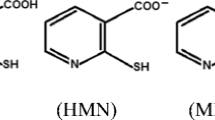Abstract
MPA stabilized CdSe/ZnS NCs was applied as a fluorescent probe for the sensitive detection of Pb2+ in water. The microreaction was demonstrated as a facile method for the reproducible synthesis of CdSe/ZnS NCs with a high quantum yield. The good stability of CdSe/ZnS NCs was proved by the significant maintaining of photoluminescent (PL) after the ligand exchange with MPA, and was further demonstrated by the excellent PL property in water solution with various pH values. The cation exchange of Zn with Pb led to the linear quenching of PL with the concentration of Pb2+, which provided as an opportunity to apply MPA stabilized CdSe/ZnS NCs as fluorescent probes for Pb2+. A facile method by adjustment of QDs concentration was demonstrated as a suitable way to approach different detection limits. The detection limits of 0.03 and 3.3 μM were achieved by setting QDs solutions with the absorbance of the first exciton peak as 0.05 and 0.15, respectively.









Similar content being viewed by others
References
Ali EM, Zheng YG, Yu HH, Ying JY (2007) Ultrasensitive Pb2+ detection by glutathione-capped quantum dots. Anal Chem 79:9452–9458
Alizadeh A, Khodaei MM, Karami C, Workentin MS, Shamsipur M, Sadeghi M (2010) Rapid and selective lead(II) colorimetric sensor based on azacrown ether-functionalized gold nanoparticles. Nanotechnology 21:315503
Chen CT, Huang WP (2002) A highly selective fluorescent chemosensor for lead ions. J Am Chem Soc 124:6246–6247
Chen P, Greenberg B, Taghavi S, Romano C, VanderLelie D, He CA (2005) An exceptionally selective lead(II)-regulatory protein from Ralstonia metallidurans: development of a fluorescent lead(II) probe. Angew Chem Int Ed 44:2715–2719
Dabbousi BO, RodriguezViejo J, Mikulec FV, Heine JR, Mattoussi H, Ober R, Jensen KF, Bawendi MG (1997) CdSe(ZnS) core-shell quantum dots: synthesis and characterization of a size series of highly luminescent nanocrystallites. J Phys Chem B 101:9463–9475
Dong CQ, Huang XY, Ren JC (2008) Characterization of water-soluble luminescent quantum dots by fluorescence correlation spectroscopy. Ann N Y Acad Sci 1130:253–261
Flegal AR, Smith DR (1995) Measurements of environmental lead contamination and human exposure. Rev Environ Contam Toxicol 143:1–45
Gerion D, Pinaud F, Williams SC, Parak WJ, Zanchet D, Weiss S, Alivisatos AP (2001) Synthesis and properties of biocompatible water-soluble silica-coated CdSe/ZnS semiconductor quantum dots. J. Phys. Chem. B 105:8861–8871
Klimov VI, Mikhailovsky AA, McBranch DW, Leatherdale CA, Bawendi MG (2000) Mechanisms for intraband energy relaxation in semiconductor quantum dots: the role of electron-hole interactions. Phys Rev B 61:R13349–R13352
Kwon JY, Jang YJ, Lee YJ, Kim KM, Seo MS, Nam W, Yoon J (2005) A highly selective fluorescent chemosensor for Pb2+. J Am Chem Soc 127:10107–10111
Landrigan PJ, Todd AC (1994) Lead poisoning. West J Med 161:153–159
Liu J, Lu Y (2003) A colorimetric lead biosensor using DNAzyme-directed assembly of gold nanoparticles. J Am Chem Soc 125:6642–6643
Luan WL, Yang HW, Fan NN, Tu ST (2008) Synthesis of efficiently green luminescent CdSe/ZnS nanocrystals via microfluidic reaction. Nano Res Lett 3:134–139
Matoussi H, Mauro JM, Goldman ER, Anderson GP, Sundar VC, Mikulec FV, Bawendi MG (2000) Self-assembly of CdSe-ZnS quantum dot bioconjugates using an engineered recombinant protein. J Am Chem Soc 122:12142–12150
Murray CB, Norris DJ, Bawendi MG (1993) Synthesis and characterization of nearly monodisperse CdE (E = sulfur, selenium, tellurium) semiconductor nanocrystallites. J Am Chem Soc 115:8706–8715
Neil DC, Jeremy MB (1998) Zinc fingers in Caenorhabditis elegans: finding families and probing pathways. Science 281:2018–2022
Pellegrino T, Kudera S, Liedl T, Javier AM, Manna L, Parak WJ (2005) On the development of colloidal nanoparticles towards multifunctional structures and their possible use for biological applications. Small 1:48–63
Ren J, Chen HL, Ren CL, Liu Q, Wang M, Chen XG (2010) l-cysteine capped CdSe as sensitive sensor for detection of trace lead ion in aqueous solution. Mater Res Innov 14:133–137
Son DH, Hughes SM, Yin YD, Alivisatos AP (2004) Cation exchange reactions in ionic nanocrystals. Science 306:1009–1012
Tu ST, Yu XH, Luan WL, Loewe H (2010) Development of micro chemical, biological and thermal systems in China: a review. Chem Eng J 163:165–179
Wuister SF, Swart I, Driel VF (2003) Highly luminescent water-soluble CdTe quantum dots. Nano Lett 3:503–507
Yang H, Luan WL, Tu ST, Wang ZM (2008) Synthesis of nanocrystals via microreaction with temperature gradient: towards separation of nucleation and growth. Lab Chip 8:451–455
Yang H, Luan W, Wan Z, Tu ST, Yuan WK, Wang ZM (2009a) Continuous synthesis of full-color emitting core/shell quantum dots via microreaction. Cryst Growth Des 9:4807–4813
Yang H, Fan NN, Luan WL, Tu ST (2009b) Synthesis of monodisperse nanocrystals via microreaction: open-to-air synthesis with oleylamine as a coligand. Nano Res Lett 4:344–352
Young AG, Green DP, McQuillan AJ (2006) Infrared spectroscopic studies of monothiol ligand adsorption on CdS nanocrystal films in aqueous solutions. Langmuir 22:11106–11112
Zhu YF, Fan DH, Shen WZ (2008) Chemical conversion synthesis and optical properties of metal sulfide hollow microspheres. Langmuir 24:11131–11136
Acknowledgments
Authors appreciated the financial supports from the Fundamental Research Funds for the Central Universities (WJ0913001), the Focus of Scientific and Technological Research Projects (109063), the State Key Laboratory of Chemical Engineering at ECUST (SKL-ChE-08C09), and National Nature Science Foundation of China (51172072).
Author information
Authors and Affiliations
Corresponding author
Rights and permissions
About this article
Cite this article
Luan, W., Yang, H., Wan, Z. et al. Mercaptopropionic acid capped CdSe/ZnS quantum dots as fluorescence probe for lead(II). J Nanopart Res 14, 762 (2012). https://doi.org/10.1007/s11051-012-0762-3
Received:
Accepted:
Published:
DOI: https://doi.org/10.1007/s11051-012-0762-3




